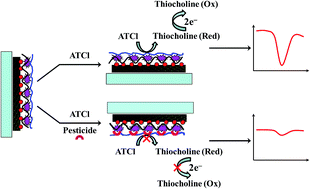A sensitive electrochemical acetylcholinesterase (AChE) biosensor based on a reduced graphene oxide (rGO) and silver nanocluster (AgNC) modified glassy carbon electrode (GCE) was developed. rGO and AgNC nanomaterials with excellent conductivity, catalytic activity and biocompatibility offered an extremely hydrophilic surface, which facilitated the immobilization of AChE to fabricate the organophosphorus pesticide biosensor. Carboxylic chitosan (CChit) was used as a cross-linker to immobilize AChE on a rGO and AgNC modified GCE. The AChE biosensor showed favorable affinity to acetylthiocholine chloride (ATCl) and could catalyze the hydrolysis of ATCl. Based on the inhibition effect of organophosphorus pesticides on the AChE activity, using phoxim as a model compound, the inhibition effect of phoxim was proportional to its concentration ranging from 0.2 to 250 nM with a detection limit of 81 pM estimated at a signal-to-noise ratio of 3. The developed biosensor exhibited good sensitivity, stability and reproducibility, thus providing a promising tool for analysis of enzyme inhibitors and direct analysis of practical samples.

